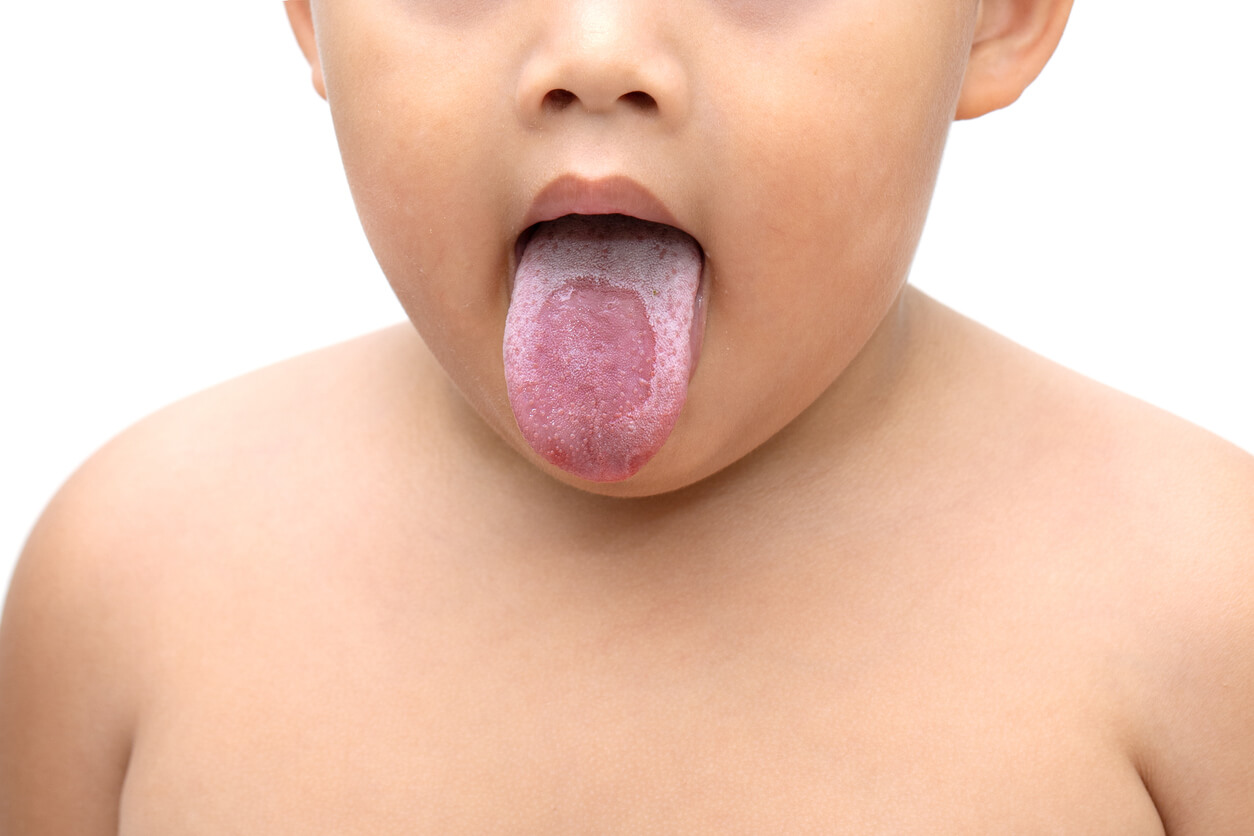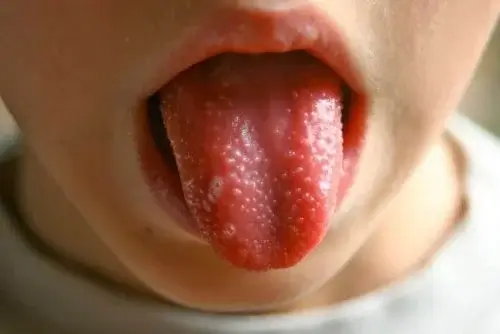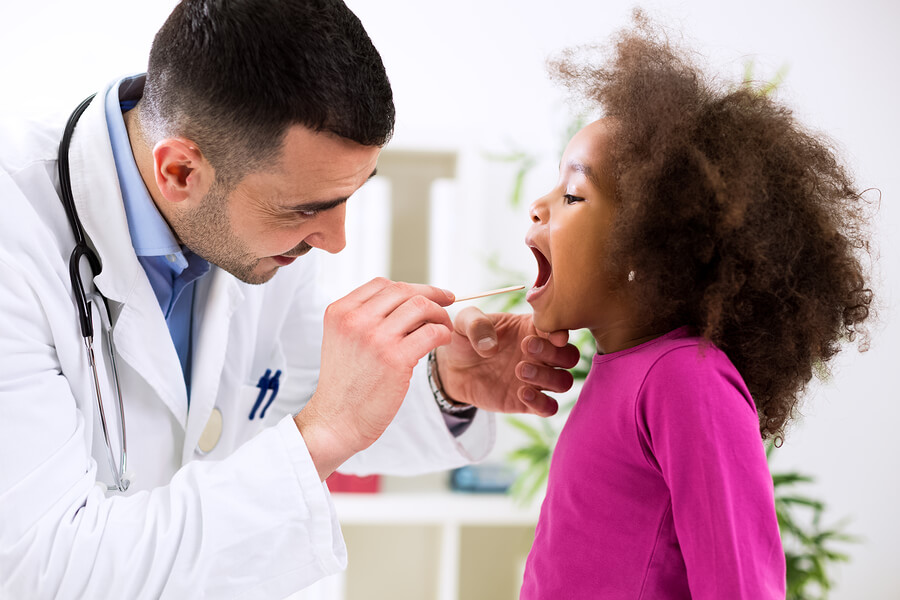6 Childhood Illnesses that Can Affect the Tongue

There are different childhood illnesses that can affect the tongue with different and varied signs. That’s why it’s important to know what this organ should look like under normal conditions and what signs indicate that something may be wrong in children.
This piece of muscle located in the oral cavity serves many functions: Sensing tastes, speaking, and eating. Many times, it’s also an indicator of a person’s general health.
There won’t always be changes in the tongue when children suffer from diseases, but if they do occur, it’s good to learn to recognize them. In this article, we’ll describe the normal tongue and some of the illnesses that alter its appearance.
What does the normal tongue of a child look like?
The tongue is a pink muscular mass with great mobility. Its tone is indicative of good health, but when it becomes white, pale, or turns bright red, there may be a problem in the body.
Similarly, the tongue is covered by a mucous membrane that gives it moisture and this condition is essential to fulfilling certain functions. In fact, when the tongue is dry, it also alerts us of a possible disease.
The surface of the tongue has small protuberances called papillae and there are 4 types of papillae:
- Foliated: these are on the sides of the tongue and are responsible for draining saliva and cleaning the organ.
- Fungiform: these are located mainly in the anterior area of the tongue and perceive taste.
- Circumvallate: these produce saliva and are located at the base of the tongue, that is, in the most posterior part.
- Filiform: these are the most numerous and are responsible for the velvety texture of the tongue. They’re responsible for the sense of touch, i.e. they allow us to recognize the texture of what we eat.
Underneath the tongue, there’s a membranous structure that serves to attach the tongue to the mouth. This is the lingual frenulum, which can also present its own defects. Children who are born with a shorter frenulum can suffer from ankyloglossia.

The most common childhood illnesses that affect the tongue
You already know what a child’s normal tongue looks like. Therefore, if your child has any alteration in the appearance of this part of the mouth, you can consult your pediatrician to find the cause of the problem.
Here are some of the childhood diseases that have manifestations in this oral organ.
1. Candidiasis
Candida albicans is a fungus that’s normally present in some parts of the body. That is, it’s part of the normal flora of human beings.
But in some circumstances, the healthy balance between this fungus and our defenses is broken and ends up infecting some structures. In the mouth, this is known as oral candidiasis or thrush and has a characteristic manifestation: The mucous membranes (including that of the tongue) are covered with white membranes that look like curdled milk.
Although it’s not a serious infection for children, it can alter the feeding mechanism. In newborns, especially, the discomfort makes breastfeeding difficult and the baby drinks less breast milk than recommended.
When the whitish plaques fall off, a reddened, burning, and painful section of the tongue remains underneath. Pediatricians usually diagnose it immediately and start treatment.
In some children, thrush may be a sign of other childhood illnesses that involve lowered defenses (immunosuppression). The frequency of these disorders is not high but should be detected in a timely manner.

2. Dehydration
Dehydration isn’t a disease per se, but a condition resulting from a lack of water in the body. It can be caused by illness, insufficient fluid intake, or increased fluid loss.
Children are more susceptible to dehydration than adults because their compensatory mechanisms are somewhat less efficient. In fact, many childhood illnesses involving dehydration, whether due to fever, vomiting, or diarrhea, are manifested by the appearance of the tongue.
In the absence of body water, the organ becomes pale or whitish and loses its characteristic moisture. Upon examination, it may feel dry and rough to the touch.
If to this we add that the child urinates less or spends a long time without urinating, is irritable, or crying occurs without tears, then a pediatrician should be consulted as soon as possible.
3. Anemia
Anemia is one of the most common childhood illnesses that affect the tongue. Due to the lack of red blood cells in the blood, both the skin and the tongue become pale. However, the most indicative lingual picture of this disorder is glossitis, which consists of inflammation of the organ, with an increase in its size, redness, and loss of papillae.
Glossitis isn’t only exclusive to iron deficiency anemia, as other micronutrient deficiencies are associated with this sign, such as vitamin B12, zinc, and folic acid deficiency.
If your little one displays tiredness, lack of concentration, weakness, brittle nails, and has pale skin and tongue, then it’s important to have them checked by a pediatrician.

4. Scarlet fever
Scarlet fever is another one of the childhood illnesses that can affect the tongue. It usually follows strep throat, as it’s caused by the same germ.
Affected children have a rash over much of their body, usually erupting at the neck. A characteristic sign is that, if this rash is pressed, the skin momentarily stops being red at that point.
In the mouth, scarlet fever is identified by the so-called “strawberry tongue“. First, the organ becomes white and swollen, with a saburral-like upper layer. Then, it turns into an intense red with many protuberances, which are the papillae that have increased in size.
The treatment of this disease is with antibiotics, as the causal agent is a bacterium. Given the symptoms, the pediatrician will know which medication to indicate.
5. Allergies
Allergies are very common during childhood. Children can suffer cutaneous reactions due to contact with an allergenic element, whether it’s insect venom, food, or animal hair.
The immune system of children is exposed to substances that are unknown to them almost constantly, but if there’s a certain susceptibility to any of them, it will trigger an allergic reaction. The tongue can be a site where the process produces symptoms: It swells and becomes redder than usual, making it difficult to speak, swallow, and even breathe.
If the reaction is large, involves other parts of the body, and involves swelling of the lips, erythema on the skin, edema on the eyelids, difficulty swallowing, and diarrhea, then immediate pediatric consultation is advisable.
6. Geographic tongue
Finally, among the childhood illnesses that can affect the tongue, we can’t fail to mention benign migratory glossitis or geographic tongue. It’s a benign and chronic disease of the tongue, which isn’t serious and doesn’t require treatment.
Its name is due to the map-like appearance of the tongue surface, as some pink or reddish spots appear on the back of the tongue, separated from each other by white borders. They change their disposition with the passage of time.
In general, this disorder doesn’t cause pain or discomfort, but in some children, it intensifies the perception of some tastes.
Its etiology is unknown, although there are different theories that try to explain its causes. There’s speculation about genetic inheritance, as there are cases in which more than one member of a family shares the trait.
In addition, there’s an association between some systemic diseases and the appearance of geographic tongue as an additional symptom. Psoriasis, atopic dermatitis, and celiac disease are some examples.

Observing the tongue
The tongue may have signs and symptoms that indicate the presence of any of the common childhood diseases. Observing your child’s mouth will allow you to notice any changes that indicate that something’s wrong and go to the pediatrician in a timely manner.
Many conditions are benign and resolve easily, but others will require complementary methods to define a diagnosis and begin timely treatment.
No one knows your child’s tongue as well as you do. So, if something seems strange to you, don’t delay in seeking medical attention.
There are different childhood illnesses that can affect the tongue with different and varied signs. That’s why it’s important to know what this organ should look like under normal conditions and what signs indicate that something may be wrong in children.
This piece of muscle located in the oral cavity serves many functions: Sensing tastes, speaking, and eating. Many times, it’s also an indicator of a person’s general health.
There won’t always be changes in the tongue when children suffer from diseases, but if they do occur, it’s good to learn to recognize them. In this article, we’ll describe the normal tongue and some of the illnesses that alter its appearance.
What does the normal tongue of a child look like?
The tongue is a pink muscular mass with great mobility. Its tone is indicative of good health, but when it becomes white, pale, or turns bright red, there may be a problem in the body.
Similarly, the tongue is covered by a mucous membrane that gives it moisture and this condition is essential to fulfilling certain functions. In fact, when the tongue is dry, it also alerts us of a possible disease.
The surface of the tongue has small protuberances called papillae and there are 4 types of papillae:
- Foliated: these are on the sides of the tongue and are responsible for draining saliva and cleaning the organ.
- Fungiform: these are located mainly in the anterior area of the tongue and perceive taste.
- Circumvallate: these produce saliva and are located at the base of the tongue, that is, in the most posterior part.
- Filiform: these are the most numerous and are responsible for the velvety texture of the tongue. They’re responsible for the sense of touch, i.e. they allow us to recognize the texture of what we eat.
Underneath the tongue, there’s a membranous structure that serves to attach the tongue to the mouth. This is the lingual frenulum, which can also present its own defects. Children who are born with a shorter frenulum can suffer from ankyloglossia.

The most common childhood illnesses that affect the tongue
You already know what a child’s normal tongue looks like. Therefore, if your child has any alteration in the appearance of this part of the mouth, you can consult your pediatrician to find the cause of the problem.
Here are some of the childhood diseases that have manifestations in this oral organ.
1. Candidiasis
Candida albicans is a fungus that’s normally present in some parts of the body. That is, it’s part of the normal flora of human beings.
But in some circumstances, the healthy balance between this fungus and our defenses is broken and ends up infecting some structures. In the mouth, this is known as oral candidiasis or thrush and has a characteristic manifestation: The mucous membranes (including that of the tongue) are covered with white membranes that look like curdled milk.
Although it’s not a serious infection for children, it can alter the feeding mechanism. In newborns, especially, the discomfort makes breastfeeding difficult and the baby drinks less breast milk than recommended.
When the whitish plaques fall off, a reddened, burning, and painful section of the tongue remains underneath. Pediatricians usually diagnose it immediately and start treatment.
In some children, thrush may be a sign of other childhood illnesses that involve lowered defenses (immunosuppression). The frequency of these disorders is not high but should be detected in a timely manner.

2. Dehydration
Dehydration isn’t a disease per se, but a condition resulting from a lack of water in the body. It can be caused by illness, insufficient fluid intake, or increased fluid loss.
Children are more susceptible to dehydration than adults because their compensatory mechanisms are somewhat less efficient. In fact, many childhood illnesses involving dehydration, whether due to fever, vomiting, or diarrhea, are manifested by the appearance of the tongue.
In the absence of body water, the organ becomes pale or whitish and loses its characteristic moisture. Upon examination, it may feel dry and rough to the touch.
If to this we add that the child urinates less or spends a long time without urinating, is irritable, or crying occurs without tears, then a pediatrician should be consulted as soon as possible.
3. Anemia
Anemia is one of the most common childhood illnesses that affect the tongue. Due to the lack of red blood cells in the blood, both the skin and the tongue become pale. However, the most indicative lingual picture of this disorder is glossitis, which consists of inflammation of the organ, with an increase in its size, redness, and loss of papillae.
Glossitis isn’t only exclusive to iron deficiency anemia, as other micronutrient deficiencies are associated with this sign, such as vitamin B12, zinc, and folic acid deficiency.
If your little one displays tiredness, lack of concentration, weakness, brittle nails, and has pale skin and tongue, then it’s important to have them checked by a pediatrician.

4. Scarlet fever
Scarlet fever is another one of the childhood illnesses that can affect the tongue. It usually follows strep throat, as it’s caused by the same germ.
Affected children have a rash over much of their body, usually erupting at the neck. A characteristic sign is that, if this rash is pressed, the skin momentarily stops being red at that point.
In the mouth, scarlet fever is identified by the so-called “strawberry tongue“. First, the organ becomes white and swollen, with a saburral-like upper layer. Then, it turns into an intense red with many protuberances, which are the papillae that have increased in size.
The treatment of this disease is with antibiotics, as the causal agent is a bacterium. Given the symptoms, the pediatrician will know which medication to indicate.
5. Allergies
Allergies are very common during childhood. Children can suffer cutaneous reactions due to contact with an allergenic element, whether it’s insect venom, food, or animal hair.
The immune system of children is exposed to substances that are unknown to them almost constantly, but if there’s a certain susceptibility to any of them, it will trigger an allergic reaction. The tongue can be a site where the process produces symptoms: It swells and becomes redder than usual, making it difficult to speak, swallow, and even breathe.
If the reaction is large, involves other parts of the body, and involves swelling of the lips, erythema on the skin, edema on the eyelids, difficulty swallowing, and diarrhea, then immediate pediatric consultation is advisable.
6. Geographic tongue
Finally, among the childhood illnesses that can affect the tongue, we can’t fail to mention benign migratory glossitis or geographic tongue. It’s a benign and chronic disease of the tongue, which isn’t serious and doesn’t require treatment.
Its name is due to the map-like appearance of the tongue surface, as some pink or reddish spots appear on the back of the tongue, separated from each other by white borders. They change their disposition with the passage of time.
In general, this disorder doesn’t cause pain or discomfort, but in some children, it intensifies the perception of some tastes.
Its etiology is unknown, although there are different theories that try to explain its causes. There’s speculation about genetic inheritance, as there are cases in which more than one member of a family shares the trait.
In addition, there’s an association between some systemic diseases and the appearance of geographic tongue as an additional symptom. Psoriasis, atopic dermatitis, and celiac disease are some examples.

Observing the tongue
The tongue may have signs and symptoms that indicate the presence of any of the common childhood diseases. Observing your child’s mouth will allow you to notice any changes that indicate that something’s wrong and go to the pediatrician in a timely manner.
Many conditions are benign and resolve easily, but others will require complementary methods to define a diagnosis and begin timely treatment.
No one knows your child’s tongue as well as you do. So, if something seems strange to you, don’t delay in seeking medical attention.
All cited sources were thoroughly reviewed by our team to ensure their quality, reliability, currency, and validity. The bibliography of this article was considered reliable and of academic or scientific accuracy.
- Bhattad, Mayur S., M. S. Baliga, and Ritika Kriplani. “Clinical guidelines and management of ankyloglossia with 1-year followup: report of 3 cases.” Case reports in dentistry 2013 (2013).
- Krishnan, P. Anitha. “Fungal infections of the oral mucosa.” Indian journal of dental research 23.5 (2012): 650.
- Chiang, Chun-Pin, et al. “Atrophic glossitis: Etiology, serum autoantibodies, anemia, hematinic deficiencies, hyperhomocysteinemia, and management.” Journal of the Formosan Medical Association 119.4 (2020): 774-780.
- Adya, Keshavmurthy, Arun Inamadar, and Aparna Palit. “The strawberry tongue: What, how and where?.” Indian journal of dermatology, venereology and leprology 84.4 (2018).
- Ogueta, I., et al. “Lengua geográfica:¿ qué es lo que un dermatólogo debería saber?.” Actas Dermo-Sifiliográficas 110.5 (2019): 341-346.
- Steffen, Richard, and Hubertus van Waes. “Enfermedades infantiles frecuentes y sus manifestaciones en la cavidad oral.” Quintessence: Publicación internacional de odontología 23.8 (2010): 378-387.
- Schling, P. The Sense of Taste.
- Pérez-Elizondo, A. D. (2017). Glositis comunes y su relación con patologías orgánicas. Revista Mexicana de Cirugía Bucal y Maxilofacial, 13(3), 83-87.
- González-Álvarez, L., García-Pola, M. J., & Garcia-Martin, J. M. (2018). Lengua geográfica: factores predisponentes, diagnóstico y tratamiento. Revisión sistemática. Revista Clínica Española, 218(9), 481-488.
This text is provided for informational purposes only and does not replace consultation with a professional. If in doubt, consult your specialist.








